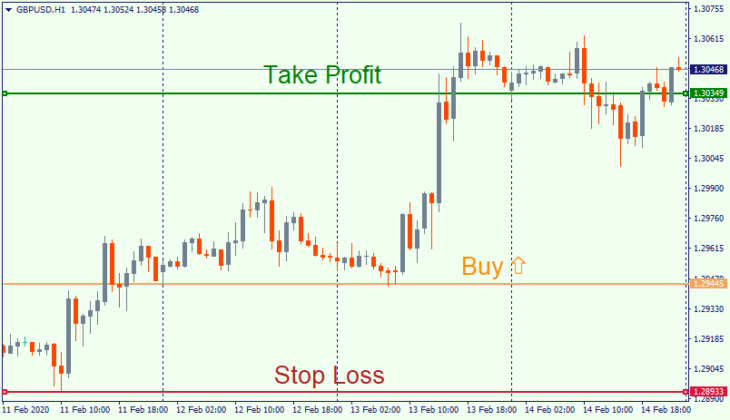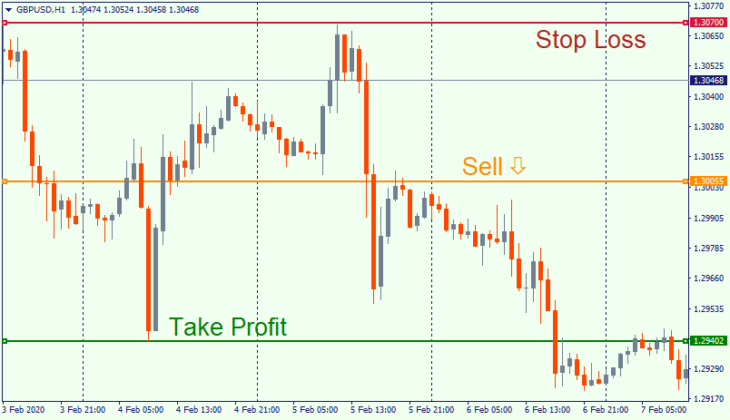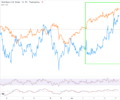There are two types of trades on Forex: buy and sell. If the trader buys, they count on the price of the asset to grow, i.e. the asset to become more expensive. If the trader sells, they suppose that the chosen currency pair price will decline.
In all examples for utility reasons we use the following parameters:
- The deposit is open in US dollars (can be opened in another currency).
- Pip is a minimal change in the price on the chart.
- The price of a pip differs from one currency pair to another depending on the current asset price and the size of the trade.
- The price of the asset is rounded up for easier calculation.
Example of a buy order
The trader opens a buy trade for EURUSD sized 1 lot at the price of 1.1000; some time later the price grew to 1.1010 which means the EUR became 10 pips more expensive compared to the USD. Keeping in mind the size of the open position (1 lot), the price of 1 lot will basically be 10 USD. In the end, closing the trade, the trader will get the profit plus 10 points or 100 dollars.
A sell order is calculated as follows
 The trader opens a sell order for the EURUSD sized 1 lot at the price of 1.1010. A little bit later, the price declined to 1.1000, which means the euro became 10 points cheaper in relation to the dollar. If the trade is sized 1 lot, this makes 100 dollars. In the end, the trader gets 100 dollars of profit, closing this trade.
The trader opens a sell order for the EURUSD sized 1 lot at the price of 1.1010. A little bit later, the price declined to 1.1000, which means the euro became 10 points cheaper in relation to the dollar. If the trade is sized 1 lot, this makes 100 dollars. In the end, the trader gets 100 dollars of profit, closing this trade.
When the trader sells, a question emerges, how can they sell what they do not own? The answer is as follows. The trader loans a trading instrument from the forex broker, be it a currency, a CFD for a stock or other asset. They sell it on the market at a certain price and after the trade is closed they give it back to the broker at the same volume. The difference between the selling price and the reverse buy is the trader’s profit. All loans and returns are carried out automatically in the terminal.
Protective orders
Protective orders are those that order the broker to close the position when a certain price is reached. For this purpose, we use the Stop Loss and Take Profit.
Take profit
This is an order to close the trade with a profit. The price, reaching the specified level, triggers the Take Profit, and the broker without the trader’s participation locks in the received profit. TPs can be placed at any time and on any profit size. Without a TP, an order will be open until the trader closes it manually. If the order is to buy, a Take Profit is placed higher than the opening price, if the order is to sell — lower than the opening price.


Stop Loss
Its purpose, unlike that of the TP, is to prevent the trader from increasing losses on an open position. An SL is placed to limit losses. For example, the trader opened a buy trade for the EURUSD at 1.1010 and specified possible loss as 10 points. The Stop Loss is placed at 1.1000, and if the price reaches it, the broker automatically closes the position with a loss of 10 points. Without an SL, the trade will last, theoretically, forever until the trader closes it manually. For a sell order, the Stop Loss is placed above the opening price, and below it — for a buy.
https://fortraders.org/en/forex-education/for-beginners/stop-loss-in-trading.html
Summary
As a rule, the placement of protective orders is under the chosen trading strategy. Currently, the usability of protective orders is discussed a lot. A TP limits the profit but allows locking it without the trader’s participation. An SL limits losses at a set level. But some may say that the price, after a movement in a losing area, may return to the profitable area, and there is a chance not to lose points. The argument will go on as long as the market exists. The final decision of whether to place TPs and SLs is always based on the trader’s experience and preferences.
Read more
https://fortraders.org/en/forex-education/for-beginners/what-is-time-frame-means.html



 SP500
SP500 FTSE
FTSE FCE
FCE Nasdaq100
Nasdaq100 Russell2000
Russell2000 Index Nikkei225
Index Nikkei225 DOW 30 (DJI)
DOW 30 (DJI) RTS futures
RTS futures RTSI
RTSI DAX30
DAX30 eBay Inc.
eBay Inc. Google Inc.
Google Inc. IBM Corp.
IBM Corp. Microsoft
Microsoft  Apple
Apple Yandex
Yandex Toyota
Toyota Volkswagen
Volkswagen Facebook
Facebook Tesla
Tesla Twitter
Twitter Hasbro
Hasbro Bitcoin
Bitcoin Litecoin
Litecoin BitcoinCash
BitcoinCash Dash
Dash Ripple
Ripple Ethereum
Ethereum EmerCoin
EmerCoin NameCoin
NameCoin PeerCoin
PeerCoin Monero
Monero ETC/USD
ETC/USD Silver
Silver Platinum
Platinum Palladium
Palladium Copper
Copper Gold
Gold